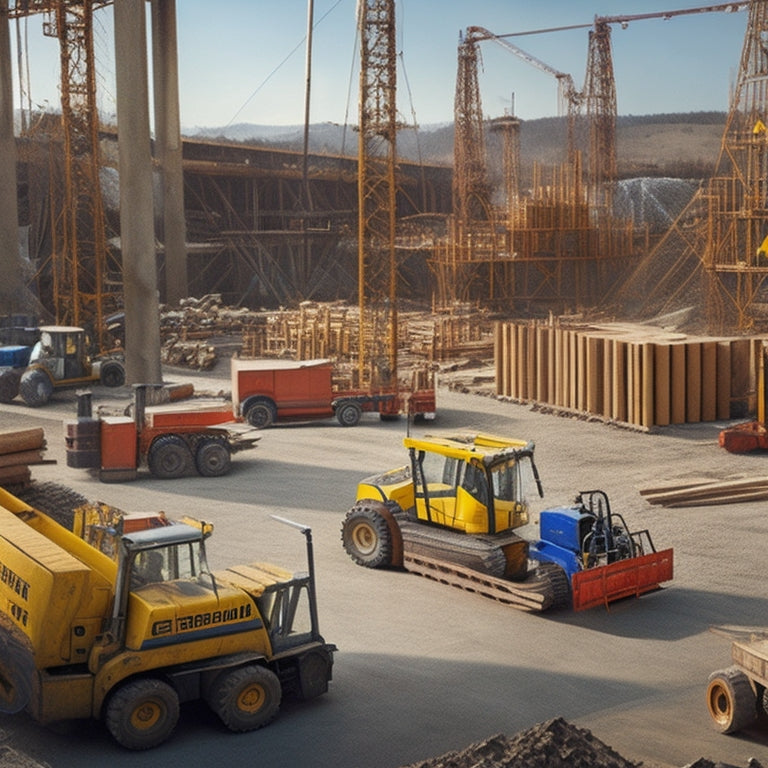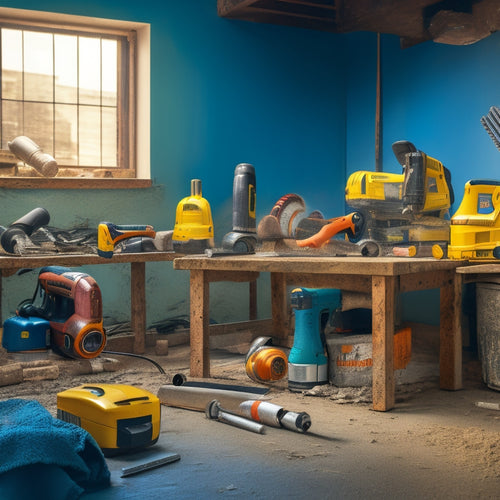
Top Tools for Organized Concrete Construction Sites
Share
You can dramatically improve your concrete construction site's efficiency by implementing top tools and strategies. Start by tracking tools meticulously with a robust inventory system, ensuring real-time visibility and identification of bottlenecks. Next, assess tool durability, material compatibility, and corrosion resistance to guarantee precision and reliability. Optimize storage and organization systems, adopting a 'clean as you go' policy and labeling tools by type and frequency. Prioritize maintenance schedules, tailoring frequency to tool type and site conditions, and design your site layout to streamline processes and reduce congestion. By mastering these essential elements, you'll reveal the full potential of your construction site, and that's just the beginning.
Key Takeaways
• Implement a robust tool tracking system for real-time visibility on tool usage and maintenance to ensure project efficiency.
• Invest in high-quality tools that meet project standards, prioritizing precision, reliability, and durability for concrete construction.
• Utilize optimal storage and organization systems, such as tool chests and cabinets, to maximize tool efficiency and reduce lost time.
• Establish proactive maintenance schedules to keep tools in ideal working condition, including regular calibration and tailored frequency.
• Adopt a 'clean as you go' policy and streamline site layout and logistics planning to reduce congestion and enhance overall productivity.
Essential Tool Inventory Management
Track your tools meticulously to guarantee that your concrete construction project stays on schedule and within budget. A well-organized tool inventory is vital to the success of your project. You can't afford to waste time searching for misplaced tools or waiting for replacements to arrive.
Implementing a robust tool tracking system guarantees that you always know where your tools are, who's using them, and when they need maintenance or replacement.
Invest in reliable inventory software to streamline your tool management process. This software helps you keep a centralized record of your tools, including their serial numbers, locations, and maintenance history.
With real-time updates, you can track tool movements, identify bottlenecks, and optimize your workflow. Additionally, inventory software sends alerts when tools are due for maintenance or calibration, preventing costly downtime and guaranteeing that your team works with precision and accuracy.
Concrete Wall Building Tool Quality
With your tool inventory management system in place, you're now ready to focus on the quality of the tools themselves, starting with those used for concrete wall building, where precision and reliability are vital to achieving straight, level, and perfectly finished walls.
The quality of your tools can make all the difference in the success of your project.
When evaluating the quality of your concrete wall building tools, you should conduct a thorough tool durability assessment.
This assessment should consider factors such as the tool's construction, material, and performance under various environmental conditions.
Additionally, a material compatibility evaluation is essential to guarantee that your tools are compatible with the specific materials you're working with.
This includes evaluating the tool's ability to effectively interact with different types of concrete, as well as its resistance to corrosion and wear.
Optimal Storage and Organization Systems
You'll maximize your concrete construction tool efficiency by implementing ideal storage and organization systems that safeguard your investment, reduce downtime, and enable quick access to the right tools for each task. A well-designed storage system guarantees that your tools are protected from damage, corrosion, and loss.
Consider investing in storage solutions like tool chests, cabinets, and shelving units specifically designed for concrete construction tools. These solutions will keep your tools organized, clean, and within easy reach.
Effective organization techniques are also essential for a seamless workflow. Labeling and categorizing your tools by type, frequency of use, and task-specific categories will help you quickly identify and retrieve the right tools for each job.
Implement a 'clean as you go' policy to prevent clutter buildup and reduce the risk of lost or misplaced tools. By streamlining your storage and organization systems, you'll save time, reduce frustration, and increase productivity on your concrete construction site.
Efficient Tool Maintenance Schedules
Establishing a proactive tool maintenance schedule guarantees your concrete construction tools remain in ideal working condition, reducing the likelihood of equipment failure and downtime. By prioritizing preventive maintenance, you'll minimize costly repairs and make certain your team stays productive. A well-planned maintenance schedule should include regular tool calibration to guarantee accuracy and precision.
Here's a sample maintenance schedule to get you started:
| Tool Category | Maintenance Frequency |
|---|---|
| Power Tools | Daily/Weekly (cleaning, lubrication) |
| Measuring Tools | Monthly (calibration, verification) |
| Heavy Equipment | Quarterly (thorough inspection, maintenance) |
Remember to tailor your schedule to your specific tools and site conditions. By staying on top of maintenance, you'll extend the lifespan of your tools, reduce waste, and maintain a safe working environment. Don't wait until it's too late – prioritize tool maintenance today and reap the benefits of a more efficient and productive concrete construction site.
Site Layout and Logistics Planning
Optimizing site layout and logistics planning streamlines your concrete construction project, enabling your team to work efficiently and safely while minimizing delays and costs.
By designing a well-organized site, you can reduce congestion, improve workflow, and enhance overall productivity.
Start by creating a site design that considers the project's specific needs, including equipment placement, material storage, and worker access. Identify potential bottlenecks and develop strategies to mitigate them.
When planning equipment placement, consider factors such as accessibility, maintenance requirements, and proximity to work areas. This will help you optimize equipment utilization and reduce downtime.
Effective logistics planning also involves coordinating material deliveries, waste management, and site traffic to guarantee a smooth operation.
Frequently Asked Questions
How Do I Handle Tool Theft or Loss on the Construction Site?
You're wise to prioritize tool theft and loss prevention on your construction site.
To minimize losses, you'll want to implement a robust tool tracking system. Start by labeling each tool with a unique identifier and recording it in a centralized database.
Next, establish a checkout system to monitor who's responsible for each tool.
Can I Use Personal Tools on a Company Construction Project?
Did you know that nearly 40% of contractors experience tool theft on the job site?
Now, about using personal tools on a company project: you should be aware of the company's personal tool policies. Typically, they'll outline what's allowed and what's not.
Keep in mind that using your own tools may shift liability from the company to you. Make certain you understand the policy to avoid any potential issues.
It's crucial to clarify this upfront to guarantee you're protected and the project runs smoothly.
Are There Any OSHA Regulations for Tool Usage and Safety?
You're right to wonder about OSHA regulations for tool usage and safety. As a construction professional, you must guarantee OSHA compliance to avoid accidents and fines.
OSHA's 29 CFR 1926.20 states that employers must provide a safe work environment, including proper tool safety training.
You're responsible for regularly inspecting tools, reporting hazards, and following manufacturer guidelines.
Stay vigilant, and you'll maintain a safe site and avoid OSHA violations.
How Often Should I Update My Tool Inventory and Ordering Process?
You're stuck between a rock and a hard place if you don't regularly update your tool inventory and ordering process.
You should review your tool inventory at least quarterly to guarantee it's aligned with your project needs.
Adjust your ordering frequency accordingly to avoid stockouts or overstocking.
Consider implementing a just-in-time inventory system to optimize efficiency and reduce waste.
What Is the Best Way to Dispose of Broken or Obsolete Tools?
When disposing of broken or obsolete tools, you'll want to prioritize recycling and responsible waste management.
Start by segregating broken tools from obsolete equipment to guarantee proper handling.
Research local recycling facilities that accept metal and electronic waste, and partner with them to responsibly dispose of broken tools.
For obsolete equipment, consider donating or repurposing functional parts, and properly dispose of the rest through licensed waste management services.
Conclusion
You've got the blueprint for a concrete construction site that's a well-oiled machine.
With essential tool inventory management, high-quality concrete wall building tool quality, and ideal storage and organization systems in place, you're ready to tackle any project.
But don't think you can rest on your laurels just yet - efficient tool maintenance schedules and site layout and logistics planning are still waiting in the wings.
Stay vigilant, and you'll be pouring foundations like a pro in no time.
Related Posts
-

Essential Tools for Concrete Wall Covering Projects
When tackling a concrete wall covering project, you'll need a range of essential tools and equipment. For cleaning an...
-

Ergonomic Concrete Tools for Tight Spaces
When you're tackling concrete work in tight spaces, ergonomic tools are your best bet for comfort and efficiency. The...
-

Essential Power Tools for Concrete Block Construction
When building with concrete blocks, you'll need a range of power tools to cut, drill, mix, and finish the blocks to g...


